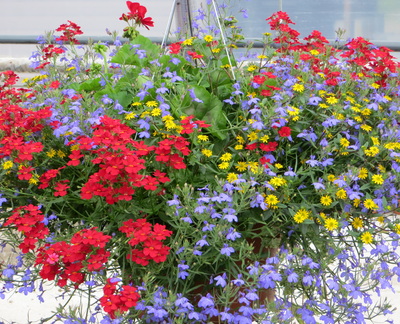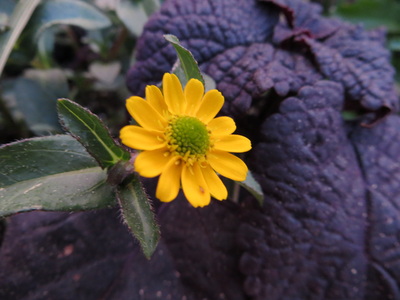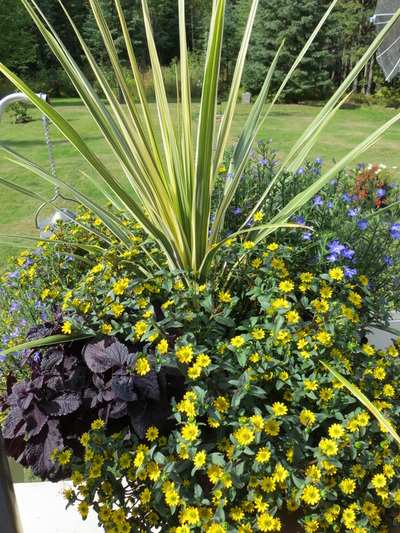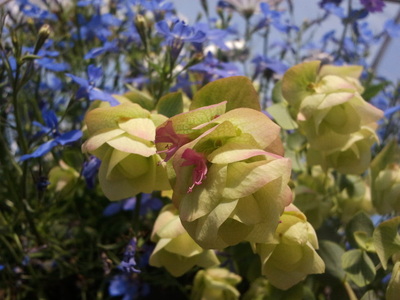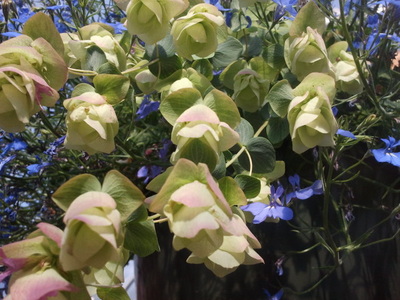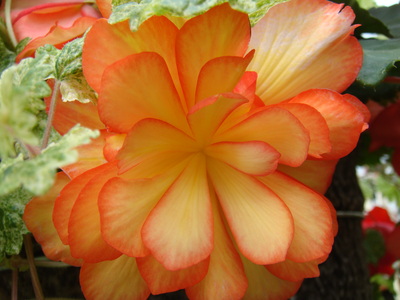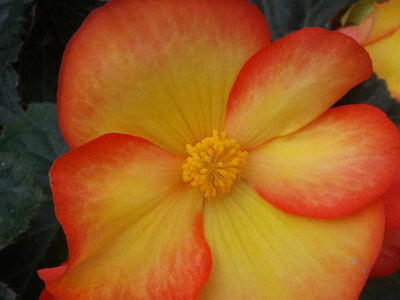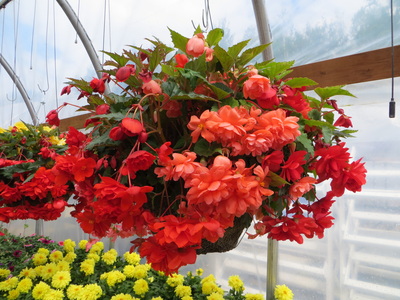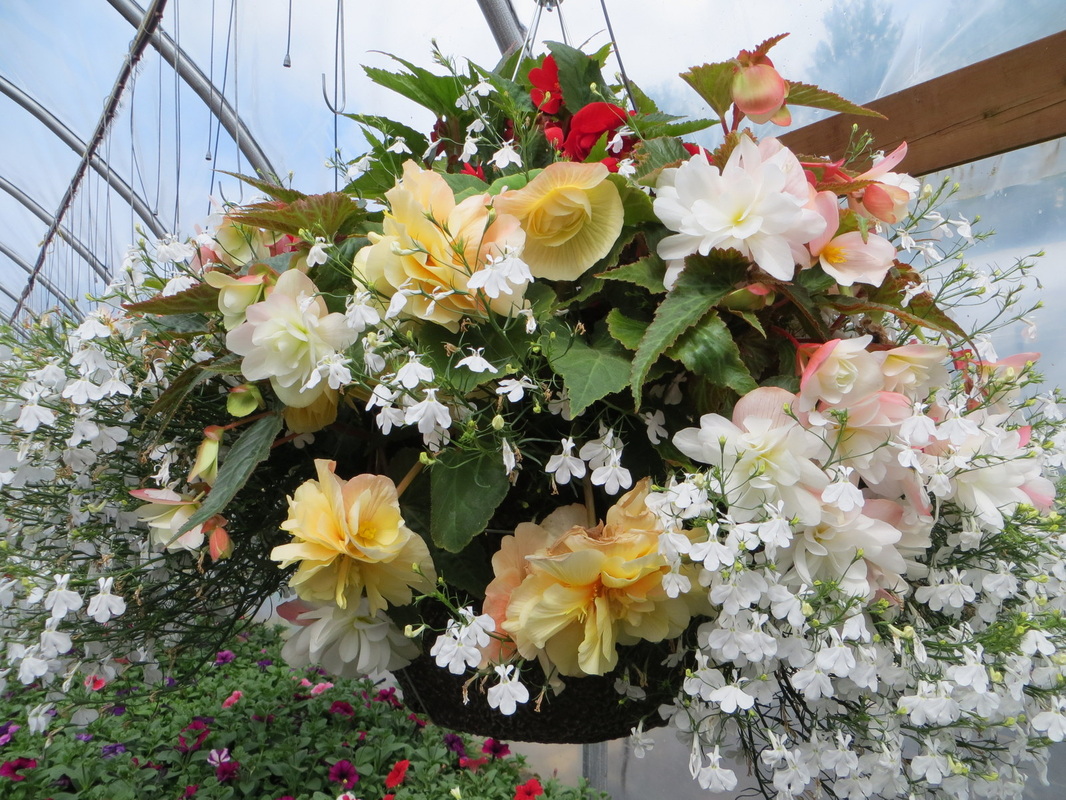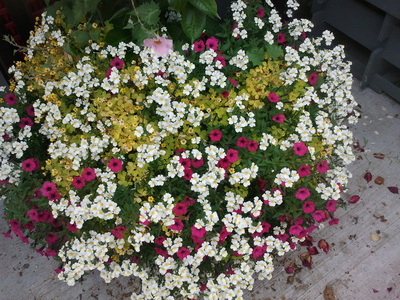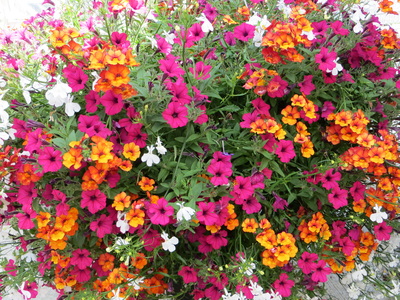2. Ornamental Oregano When we first received ornamental oregano plugs (tiny plants) a few years ago, we had no preconceived notions about them. Indeed, the plants smelled like oregano but nothing else jumped out at us....until about 8 weeks later. As it turns out, ornamental oregano is a real gem. Ornamental oregano has showy, hop-like bracts. (The actual flowers are the small pink florets growing sparsely around the bracts.) The bracts are about 1" in diameter and have a drooping growth habit, hanging like clusters of bells. The main bract colour is a soft, creamy lime-green, with tinges of pink. The pink becomes more prominent with cool nights. The bracts don't turn brown and papery for months, and may even last the entire growing season. The foliage of oregano has unusual blue-green colouring and delicate burgundy veining. The leaves are small, leathery and quite tough. This page has some beautiful photos of ornamental oregano: http://www.rainyside.com/plant_gallery/herbs/OriganumBarbaraTingey.html Growing Tips Ornamental oregano likes full to part sun. It does perfectly fine with moist or dry soil. Like sanvitalia it is a fairly compact grower, so choose plant companions that aren't overly aggressive. Its growth habit is advantageous if you have hanging baskets where you would rather see the pot than cover it. Ornamental oregano is one of those plants that is best admired close-up. Use it in baskets hung at eye level or slightly higher. Interestingly, this plant is rated hardy to Zone 4 so it very well might winter in the ground. We haven't tried that yet, but when we do, we will report back. 3. Illumination Begonia Of all the plants here, illumination begonias are the belles of the ball. Their high impact blossoms are brightly coloured and ruffled, having an unmistakable femininity about them. Each plant actually has two types of flowers: the full, double male flowers and the single female flowers. 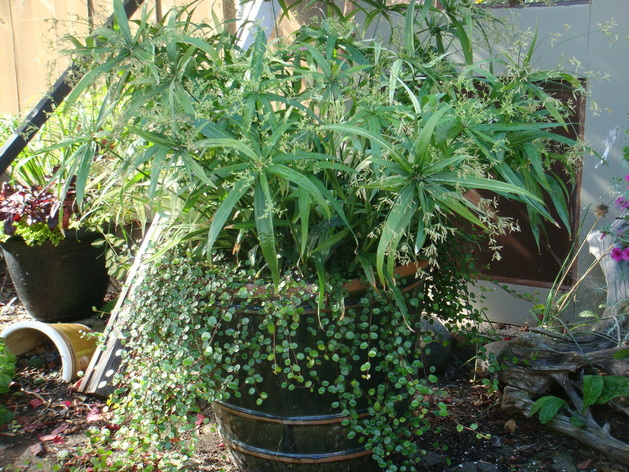 Growing Tips Illumination begonias thrive in full shade, part shade or part sun. Basically, they take any exposure except the hot afternoon sun (from about 1-4 pm). To keep begonias happiest, I let the soil dry slightly between waterings. They may rot if the soil is consistently wet, particularly early in the season. It's not usually a problem in our climate, but powdery mildew fungus does occasionally affect begonias. Proper watering practices will normally prevent powdery mildew. Try to water plants in the morning/early afternoon (instead of the evening) and avoid wetting the leaves when watering. Here is a link to the rose coloured illumination begonia but you can also peruse other series colors: https://www.provenwinners.com/plants/begonia/illumination-rose-tuberous-begonia-begonia-x-tuberhybrida 4. Creeping Wire Vine (Small leaf Muehlenbeckia) I first met wire vine in 2010 when I was running a greenhouse in Kamloops. It just so happened that one of my perennial suppliers had a few flats of it on his delivery truck. I honed in on this mysterious plant, as I usually do when I see something I don't recognize. Wire vine was being marketed as a perennial ground cover, but with its trailing growth habit, I thought it might work well in containers. Did it ever. A few years later we started using it in hanging baskets with equally impressive results. Small leaf wire vine has tiny, glossy round leaves and stiff brown stems. The growth habit is unique because it somewhat stiff and yet still flowing. The stems are thread-like and really do resemble thin gauge wire. It is a medium-vigour trailer, growing about 2 feet long. Much of its beauty is in its versatility. This vine will grow in full sun to full shade and it's evergreen. Growing Tips Wire vine is grown for its foliage. It makes an excellent backdrop for flowering basket stuffers. Wire vine tolerates a wide range of soil conditions and grows well in full sun to full shade (although it likely gets bigger in sun.). Wire vine is one of those plants that almost every gardener has success growing. It is worth mentioning that we recommend the small leaf muehlenbeckia over the large leaf muehlenbeckia. For whatever reason, aphids love the big leaf variety but don't seem bother the small leaf variety. Growing wire vine also has its economical benefits because it is winter hardy. I tested this in my garden last year by planting some into the ground. Every last one survived, including the seven plants I dumped into my compost pile. So once you have this plant, you can reuse it in future seasons. For more photos and information see: https://www.provenwinners.com/plants/muehlenbeckia/small-leaf-creeping-wire-vine-muehlenbeckia-axillaris 5. Sangria Charm Petunia Sangria Charm is a stand-out amongst the 100's of other wonderful trailing petunias on the market, even compared to the other Charm Series petunias. Sangria Charm is extra special because of its little scalloped blossoms, bushy growth habit and true no-deadhead requirements. Sangria Charm does not get straggly during summer's heat nor are the flowers easily destroyed by rain. Growing Tips
Like other petunias, Sangria Charm likes full to part sun. It has a dense growth habit and maintains a ball-like shape. I find it pairs well with airier plants like nemesia, lobelia and verbena. Get more information about Sangria Charm petunia here: https://www.provenwinners.com/plants/petunia/supertunia-sangria-charm-petunia-hybrid In Summary... I hope I've given you some dreamy new ideas for your hanging baskets. If you already grow these plants, this post is just proof of your great taste :) We use all of these top five plants in our ready-made hanging baskets too. Come and check them out this spring if you want to see them in action.
3 Comments
|

